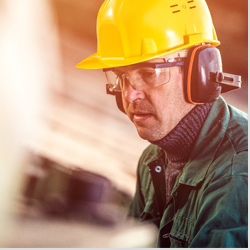Hearing protection is important in some workplaces to protect employees from causing temporary or permanent damage to their inner ears that can not only decrease their productivity and health, but cause long-term issues.
Our sense of hearing is actually fairly delicate and sensitive, and therefore vulnerable to damage. Ignoring the need for hearing protection could put your employees at risk of tinnitus, decreased hearing ability, temporary hearing loss, and even long-term hearing loss.
Government research has shown that prolonged exposure to noise of just 85db, comparable to the volume of heavy city traffic, can begin to cause damage, so your workplace might be more damaging to hearing than you’d think, even if you don’t think it’s exceptionally loud.
Types of hearing protection
- - Corded/banded ear plugs – Corded and branded ear plugs are a popular choice in workplaces where earplugs are regularly used and you don’t want them to get lost, for example in food manufacture.
- - Disposable ear plugs – If you prefer disposable protection, disposable ear plugs offer a high level of protection and comfort for the wearer on a one-use basis.
- - Ear defenders and muffs – A range of ear muff-style ear protectors exist which offer excellent standards of noise protection and comfort for the wearer.
Hearing protection laws and regulations
Based on the Control of Noise at Work Regulations 2005, employers are expected to provide sound cancelling ear plugs for all employees when measures of noise control have been taken and ear protection from noise is needed. Ear protection must be provided if employees are exposed to noise between the lower and upper exposure action values; 85 decibels of daily or weekly exposure. You can use the HSE exposure calculator to work out how much noise your workplace creates. Employees must be trained in how to use their ear protection correctly and safely, and when it must be worn. Hearing protection zones in the workplace must also be identified, in places where the use of sound cancelling earplugs or equipment is required.
How to choose the correct hearing protection?
There are a number of points to consider when choosing the best noise reduction equipment. Our advice is:
- - Ensure that the ear protection limits noise to below 85 dB at the ear to guarantee good levels of protection.
- - Think about the working environment, including how often the protection needs to be worn, and take into account the wearer’s comfort.
- - Consider what other PPE employees will be wearing, and how this may work with other noise reduction equipment. People wearing hats and helmets, for example, may be more suited to helmet-mounted ear protection.
- - The best noise reduction earplugs should cancel sound whilst being comfortable to wear, any discomfort should be handled immediately before further damage is caused.
If you know what equipment you need, browse our full collection of hearing protection equipment and order online today. If you have any questions about the products available, please don’t hesitate to contact our team who will be happy to advise.





Leave a comment